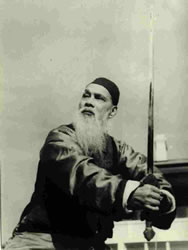
Back ওয়াং জি-পিং Bengali/Bangla وانگ زیپینگ CKB وانگ زی-پینگ Persian वांग ज़ी-पिंग Hindi Wang Zi-Ping Italian 王子平 Japanese വാങ് സി-പിങ് Malayalam 王子平 Chinese
| Wang Ziping | |
|---|---|
 | |
| Born | 1881 Cangzhou, Hebei, Qing China |
| Died | 1973 (aged 91–92) Illness |
| Native name | 王子平 |
| Nationality | Chinese |
| Style | Wushu: Chaquan, Huaquan, Leopard kung fu, Bajiquan, Tai chi |
| Teacher(s) | Chaquan: Yang Hongxiu |
| Rank | Grandmaster |
| Notable relatives | Wang Jurong (daughter) |
| Wang Ziping | |||||||||
|---|---|---|---|---|---|---|---|---|---|
| Traditional Chinese | 王子平 | ||||||||
| Simplified Chinese | 王子平 | ||||||||
| |||||||||
| Part of a series on |
| Chinese martial arts (Wushu) |
|---|
 |
Wang Ziping (1881–1973, Xiao'erjing: وْا ذِ پٍ) was a Chinese Muslim[1] practitioner of Chinese Martial Arts and traditional medicine from Cangzhou, Cangxian county, Mengcun, Hebei Province.[2] He served as the leader of the Shaolin kung fu division of the Martial Arts Institute in 1928 and was also the vice chairman of the Chinese Wushu Association.[3] Wang was known for his mastery of Chaquan, Huaquan, Leopard kung fu, Bajiquan, and tai chi.[4] He was also a master of Wushu.[5][6][7]
- ^ Thomas A. Green, Joseph R. Svinth (2010). Thomas A. Green; Joseph R. Svinth (eds.). Martial Arts of the World: An Encyclopedia of History and Innovation, Volume 2 (illustratedpublisher=ABC-CLIO ed.). Bloomsbury Academic. p. 343. ISBN 978-1598842432. Retrieved 2012-10-08.
Muslims also have been active in shuai- jiao ( Chinese wrestling), a famous twentieth-century proponent being Wang Ziping ( 1881–1973).
- ^ Nigel, Andrew (2004). "Pioneer of Therapeutic Martial Arts in North America." Kung Fu Tai Chi, Jan/Feb, 59-63
- ^ Grace Xiaogao Wu-Monnat. "Growing Up With Wang Ziping and Madam Wang Jurong". Retrieved 2008-11-04.
- ^ John E. Young, PhD (2016). Learning of the Way (Daoxue):: Self-Cultivation Through Neo-Confucian Learning, Kungfu, and Martial Arts. Archway Publishing. ISBN 978-1-4808-3049-3.
- ^ "Grandmaster Wang, Zi-Ping (1881-1973)". GLENRIDGE Martial Arts Academy. Retrieved 18 June 2014.
- ^ "Estilos de Wushu/Kungfu". Golden Dragon (in Spanish and English). Retrieved 18 June 2014.
- ^ "GRANDES MAESTROS DE SHANDONG WUSHU". Chinese Culture and Martial Arts. Archived from the original on June 21, 2006. Retrieved 18 June 2014.